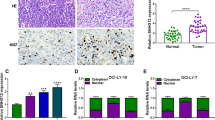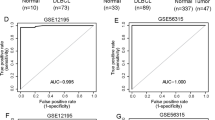Abstract
Despite improved survival for the patients with diffuse large B cell lymphoma (DLBCL), the prognosis after relapse is poor. LincRNA-p21 is a long intergenic noncoding RNA, which is located on chromosome 17, approximately 15 kb upstream from the Cdkn1a (p21) gene. However, its clinical importance and biological role in DLBCL prognosis are unknown. In this study, we conducted quantitative reverse-transcription polymerase chain reaction to investigate the lincRNA-p21 expression in DLBCL. We found that lincRNA-p21 levels were markedly decreased in DLBCL tissues compared with normal. Its expression level was significantly correlated with Ann Arbor stages, B symptoms, performance status, IPI score and serum LDH. Moreover, patients with high levels of LincRNA-p21 expression had a favorable overall survival and progression-free survival. Furthermore, ectopic expression of lincRNA-p21 inhibited cell proliferation, arrested cycle progression and modulated cyclin D1, CDK4 and p21 expression in DLBCL cell lines. These results demonstrated lincRNA-p21 can be identified as a potential novel prognostic biomarker for prognosis in DLBCL and regulate cell proliferation and cycle in vitro. Our findings highlight the value of integrated comprehensive analysis to identify prognostic markers and genetic driver events not previously implicated in DLBCL.




Similar content being viewed by others
References
Martelli M, Ferreri AJ, Agostinelli C, Di Rocco A, Pfreundschuh M, Pileri SA. Diffuse large B-cell lymphoma. Crit Rev Oncol Hematol. 2013;87(2):146–71.
Feugier P, Van Hoof A, Sebban C, Solal-Celigny P, Bouabdallah R, Ferme C, et al. Long-term results of the R-CHOP study in the treatment of elderly patients with diffuse large B-cell lymphoma: a study by the Groupe d’Etude des Lymphomes de l’Adulte. J Clin Oncol. 2005;23(18):4117–26.
Lee HJ, Shin DH, Kim KB, Shin N, Park WY, Lee JH, et al. Polycomb protein EZH2 expression in diffuse large B-cell lymphoma is associated with better prognosis in patients treated with rituximab, cyclophosphamide, doxorubicin, vincristine and prednisone. Leuk Lymphoma. 2014;55(9):2056–63. doi:10.3109/10428194.2013.858816.
Vaidya R, Witzig TE. Prognostic factors for diffuse large B-cell lymphoma in the R(X)CHOP era. Ann Oncol. 2014;25(11):2124–33. doi:10.1093/annonc/mdu109.
Hu Y, Ding N, Jin X, Feng L, Ping L, Song Y, et al. Genetic polymorphisms of STAT3 correlated with prognosis in diffuse large B-cell lymphoma patients treated with rituximab. Cancer Cell Int. 2014;14(1):25.
Taskinen M, Louhimo R, Koivula S, Chen P, Rantanen V, Holte H, et al. Deregulation of COMMD1 is associated with poor prognosis in diffuse large B-cell lymphoma. PLoS One. 2014;9(3):e91031. doi:10.1371/journal.pone.0091031.
Roschewski M, Staudt LM, Wilson WH. Diffuse large B-cell lymphoma-treatment approaches in the molecular era. Nat Rev Clin Oncol. 2014;11(1):12–23. doi:10.1038/nrclinonc.2013.197.
Koh YW, Park C-S, Yoon DH, Suh C, Huh J. Should the cut-off values of the lymphocyte to monocyte ratio for prediction of prognosis in diffuse large B-cell lymphoma be changed in elderly patients? Eur J Haematol. 2014;93(4):340–8. doi:10.1111/ejh.12354.
Ponting CP, Oliver PL, Reik W. Evolution and functions of long noncoding RNAs. Cell. 2009;136(4):629–41.
Tsai M-C, Manor O, Wan Y, Mosammaparast N, Wang JK, Lan F, et al. Long noncoding RNA as modular scaffold of histone modification complexes. Science. 2010;329(5992):689–93.
Tsai M-C, Spitale RC, Chang HY. Long intergenic noncoding RNAs: new links in cancer progression. Cancer Res. 2011;71(1):3–7.
Feng S, Yao J, Chen Y, Geng P, Zhang H, Ma X, et al. Expression and functional role of reprogramming-related long noncoding RNA (lincRNA-ROR) in glioma. J Mol Neurosci. 2015;. doi:10.1007/s12031-014-0488-z.
Hall JR, Messenger ZJ, Tam HW, Phillips SL, Recio L, Smart RC. Long noncoding RNA lincRNA-p21 is the major mediator of UVB-induced and p53-dependent apoptosis in keratinocytes. Cell Death Dis. 2015;6:e1700. doi:10.1038/cddis.2015.67.
Huarte M, Guttman M, Feldser D, Garber M, Koziol MJ, Kenzelmann-Broz D, et al. A large intergenic noncoding RNA induced by p53 mediates global gene repression in the p53 response. Cell. 2010;142(3):409–19. doi:10.1016/j.cell.2010.06.040.
Yoon JH, Abdelmohsen K, Srikantan S, Yang XL, Martindale JL, De S, et al. LincRNA-p21 suppresses target mRNA translation. Mol Cell. 2012;47(4):648–55. doi:10.1016/j.molcel.2012.06.027.
Wang GY, Li ZW, Zhao Q, Zhu YY, Zhao C, Li X, et al. LincRNA-p21 enhances the sensitivity of radiotherapy for human colorectal cancer by targeting the Wnt/beta-catenin signaling pathway. Oncol Rep. 2014;31(4):1839–45. doi:10.3892/or.2014.3047.
Dimitrova N, Zamudio JR, Jong RM, Soukup D, Resnick R, Sarma K, et al. LincRNA-p21 activates p21 in cis to promote Polycomb target gene expression and to enforce the G1/S checkpoint. Mol Cell. 2014;54(5):777–90. doi:10.1016/j.molcel.2014.04.025.
Peng W, Gao W, Feng J. Long noncoding RNA HULC is a novel biomarker of poor prognosis in patients with pancreatic cancer. Med Oncol. 2014;31(12):346. doi:10.1007/s12032-014-0346-4.
Peng W, Wu G, Fan H, Wu J, Feng J. Long noncoding RNA SPRY4-IT1 predicts poor patient prognosis and promotes tumorigenesis in gastric cancer. Tumour Biol. 2015;. doi:10.1007/s13277-015-3376-4.
Peng W, Zhang J, Liu J. URG11 predicts poor prognosis of pancreatic cancer by enhancing epithelial-mesenchymal transition-driven invasion. Med Oncol. 2014;31(7):64. doi:10.1007/s12032-014-0064-y.
Lossos IS. Molecular pathogenesis of diffuse large B-cell lymphoma. J Clin Oncol. 2005;23(26):6351–7. doi:10.1200/jco.2005.05.012.
Martelli M, Ferreri AJM, Agostinelli C, Di Rocco A, Pfreundschuh M, Pileri SA. Diffuse large B-cell lymphoma. Crit Rev Oncol Hematol. 2013;87(2):146–71. doi:10.1016/j.critrevonc.2012.12.009.
Lossos IS, Morgensztern D. Prognostic biomarkers in diffuse large B-cell lymphoma. J Clin Oncol. 2006;24(6):995–1007. doi:10.1200/jco.2005.02.4786.
Peng W, Fan H, Wu G, Wu J, Feng J. Upregulation of long noncoding RNA PEG10 associates with poor prognosis in diffuse large B cell lymphoma with facilitating tumorigenicity. Clin Exp Med. 2015. doi:10.1007/s10238-015-0350-9
Barnes DM. Cyclin D1 in mammary carcinoma. J Pathol. 1997;181(3):267–9. doi:10.1002/(sici)1096-9896(199703)181:3<267:aid-path783>3.0.co;2-x.
Nakamura S, Yatabe Y, Seto M. Cyclin D1 overexpression in malignant lymphomas. Pathol Int. 1997;47(7):421–9. doi:10.1111/j.1440-1827.1997.tb04519.x.
Kitagawa M, Higashi H, Jung HK, SuzukiTakahashi I, Ikeda M, Tamai K, et al. The consensus motif for phosphorylation by cyclin D1-Cdk4 is different from that for phosphorylation by cyclin A/E-Cdk2. EMBO J. 1996;15(24):7060–9.
Kumar R, Gururaj AE, Barnes CJ. p21-activated kinases in cancer. Nat Rev Cancer. 2006;6(6):459–71. doi:10.1038/nrc1892.
Abbas T, Dutta A. p21 in cancer: intricate networks and multiple activities. Nat Rev Cancer. 2009;9(6):400–14. doi:10.1038/nrc2657.
Acknowledgments
This work was supported by grants from Agency of Jiangsu Province Science and Technology (No. 2013035) and Research Office of Jiangsu Cancer Hospital (No. ZK201401).
Author information
Authors and Affiliations
Corresponding author
Ethics declarations
Conflict of interest
None.
Rights and permissions
About this article
Cite this article
Peng, W., Wu, J. & Feng, J. LincRNA-p21 predicts favorable clinical outcome and impairs tumorigenesis in diffuse large B cell lymphoma patients treated with R-CHOP chemotherapy. Clin Exp Med 17, 1–8 (2017). https://doi.org/10.1007/s10238-015-0396-8
Received:
Accepted:
Published:
Issue Date:
DOI: https://doi.org/10.1007/s10238-015-0396-8




